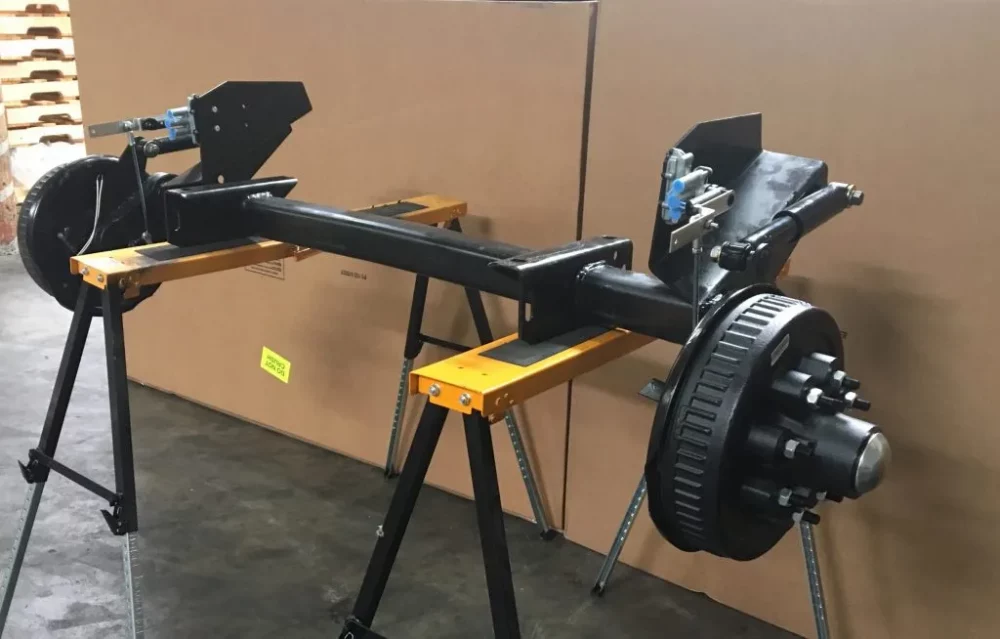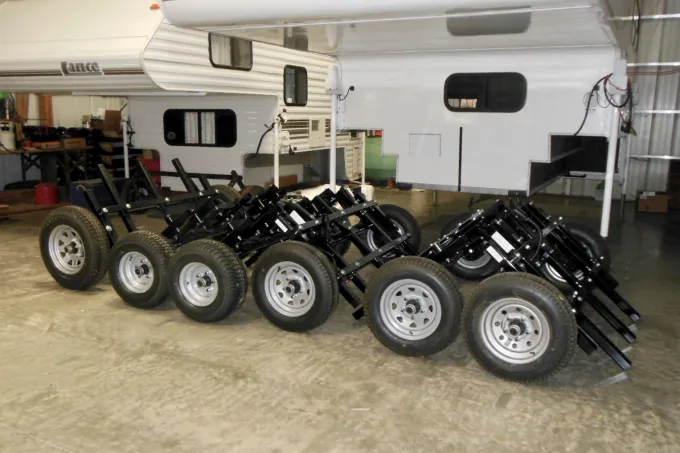What Does the Tag Axle Do in an RV?
It’s easy to determine what an axel does on an RV in a technical, engineering sense. But what does an axle do in your average recreational vehicle? What purpose does it serve? It may sound simplistic, but the tag axle serves many purposes. Of course, the primary function of all four axels is to support the weight of your RV and help it glide smoothly across the ground.

Contents
- 1 What Is Tag Axle for RV?
- 2 How Do Tag Axles Work?
- 3 Where Is the Tag Axle Located in a Motorhome?
- 4 When Do You Need to Use the Tag Axle?
- 5 How Many Tires Go on the RV Tag Axle?
- 6 Benefits of the Tag Axle on a Motorhome
- 7 Disadvantages of an RV Tag Axle
- 8 Tag Axle vs. Pusher Axle
- 9 Best Tag Axle Motorhomes
What Is Tag Axle for RV?
Tag axles refer to the additional axles located behind the drive axle. It’s included in the design of RVs that are very long and heavy.
The tag axle enables vehicles to maintain forward momentum when turning and guarantees high-performance levels during periods of sudden braking, acceleration, and cornering on different types of roads.
Why Is It Called Tag Axle?
Your RV’s tag axle is not added to the vehicle’s hitch but to the frame itself. It’s called “tag axle” because it doesn’t start at the hitch and run forward like the other axles but rather comes off from behind or from the “tag end” of an already existing axle.
How Do Tag Axles Work?
Tag axles are similar to the typical front and rear axles, but their main purpose is to help support different loads without falling over. They roll and stop at command and do not act as individual parts when it comes down to driving the vehicle.
The tag axle doesn’t have power going to it, so you don’t have to think about breaking the tag axle or having a differential. You might hear tag axles described as “dead axles” because they receive no power from the engine and don’t contribute to forward momentum.
Because tag axles are designed to improve handling and weight distribution, they are most common on larger RVs. In fact, larger RVs often have two sets of tandem rear wheels to distribute weight more evenly over eight wheels instead of just four. These tandem-axle RVs can benefit even more from the tag axle in higher weights and better handling.
Tag axles for RVs with two front wheels and two tandem rear wheels will improve stability at speeds around 40 miles per hour or more. But tag axles do not help with acceleration or braking; they are all about steering stability.
Where Is the Tag Axle Located in a Motorhome?
Not all motorhomes have tag axles, but those that do are usually very large, luxury-class vehicles.
The tag axle sits behind the rear axle of a motorhome. Since the tag axle is simply a tool for the rear axle to follow the front, it doesn’t need a differential. Without a differential, the motorhome gets better performance and handling.
When Do You Need to Use the Tag Axle?
If your recreational vehicle (RV) has a single axle, it won’t be able to accommodate the extra weight you desire. Therefore, you need the tag axle to carry the extra weight and stabilize the RV.
It would help if you had the tag axle on your RV because the vehicle manufacturer wants to meet your demand as a customer. You need more valuable and modern amenities and features that can only be supported if you have an axle to carry the weight for your comfort.
When your RV has the tag axle fixed, you can throw in heavy items as you go for that trip. You can carry more clothes and camping gear.
You can also install a fridge and stock food that can sustain you in the woods far from the city for quite some time.
How Many Tires Go on the RV Tag Axle?
The tag axle will have two tires. Sometimes, manufacturers will offer a third tire as an option. Adding this third tire may increase the carrying capacity of your motorhome slightly.
Benefits of the Tag Axle on a Motorhome
There are many advantages of having tag axles on your RV. Let’s learn more.
a) Vehicle Stability
When it comes to your vehicle, the tag axle can stabilize it and help hold it upright, so you don’t have to worry about being blown around in the wind while driving.
b) Tag Axle Supports More Weight
When your RV has the tag axle, you can load the vehicle with a weight of up to 20,000 pounds of items. A normal drive axle cannot support this weight without the risk of accidents.
c) Smooth Rides
Tag axles act as shock absorbers in motorhomes. They can help reduce shocks and jolts that would otherwise make your experience on the road stressful.
d) More RV Amenities
A single set of wheels cannot hold up against all appliances and utilities needed to ensure a comfortable venture. When you need fridges, cookers, and storage features in your motorhome, upgrading to the tag axle is absolutely essential.
e) Rear Support
Your RV’s tag axle is a reinforced axle placed behind the main axle. It can serve to support the weight or to help with stability. It will increase the amount of weight that your vehicle can support.
f) Makes Cornering Sharper and Safer
The main reason why tag axles are common on RVs is that they give better grip when driving through corners due to their weight distribution: having two wheels close together means there’s less rolling resistance than if you had just one wheel at each corner (which would slip more easily).

Disadvantages of an RV Tag Axle
Tag axles in RVs come with some drawbacks as well:
a) High Costs
These axles often wear off in a short period, which is an added expense for the RV owner. The rig also costs many dollars to maintain.
b) Tag Axle Rig Is Long
Motorhomes equipped with tag axles are longer than standard coaches. The design makes navigating sharp turns or small spaces more difficult, like parking lots.
c) Difficulty Navigation
Motorhomes equipped with tag axles typically weigh far more than standard coaches because of the weight added by the additional axle. The configuration makes it difficult to navigate the rig without damaging the vehicle or its passengers.
d) Hard To Pull the Rig Out of a Jam
If your coach gets stuck in mud or snow, it can be nearly impossible to pull it out of the jam without wrecking your vehicle or tearing down barriers around you, such as fences and bushes.
Tag Axle vs. Pusher Axle
Both tag and pusher axles are perfect for any application that requires flexibility in turning or driving situations. These axles are characteristically independent because they both do not require a power source.
What differentiates the two is that the tag sits behind, while the pusher axle sits in front of a drive axle.
Curiously, a pusher axle is designed to take a dip for the drivetrain to easily reach the vehicle’s drive axle. On the other hand, tag axles do not dip. Remember “tag” as at the back and “pusher” as in front.
The pusher axle carries a heavier weight compared to the tag axle. The tag axle only carries the actual axle weight and not the overall weight of the rig.
Best Tag Axle Motorhomes
A few axle-tag motorhomes will make you proud to be an RV owner despite the high costs.
a) Winnebago Tour Coach
The Winnebago Tour is the ideal luxury motorhome for those with a taste for adventure. It has an innovative slide-out design, extending to accommodate a full-height king bed. The Tour also has an expansive wardrobe, shower and toilet room, and a kitchen area with everything you need to make your stay at the campsite comfortable.
b) Monaco Coach
Monaco Coach is famous for its tag axle diesel motorhomes. A Monaco tag axle motorhomes fleet is called “America’s Luxury Bus.” Its models are known for their smooth ride and fuel economy.
c) Newmar Dutch Star
The Newmar Dutch Star is known as one of the most luxurious motorhomes in existence. It’s super spacious, highly customizable, and comes with various options to suit your needs. It also has a well-functioning tag axle.
d) Adria Coral Motorhome
This is the best motorhome with a fully functional tag axle. This motorhome has a large lounge, which you can convert into a bed for two people. It has a storage space under the bed, and it also has a big kitchen and a big shower room.
e) Chausson Welcome 75 Motorhome
This motorhome has a well-designed tag axle, and it is 6 meters long. Its payload is 880kg, so it can carry more weight than any other motorhome. It also has a fixed rear double bed and over cab double bed, sleeping four people simultaneously.
As is the case with most equipment, tag axles on RVs serve one basic purpose: it helps to balance the weight distribution so that your coach handles better and is more stable while underway.
Though tag axles are invaluable additions to RVs, they’re also easy to overlook when you’re not familiar with them. But, it’s good to know what they do and why they exist; they’re an important part of your RV.
